Rhinoceros and dinosaurs are lookalikes. The enormous bulky body, the broad shoulders, the exigent horns, etc., make people think of them as related somehow. But is a rhinoceros a dinosaur?
Rhinoceros is not a dinosaur. They are mammals and give birth, whereas the dinosaurs were reptiles and lay eggs.
So Rhinos are far from being related to any dinosaurs. But then, what are rhinoceros’ ancestors?
Rhinoceros are mammals and have relations to other mammals. Such as tapirs. Rhinos come from prehistoric animals and have gone through several extinctions. They have lost many of their species in the process, and now only 5 of them are alive.
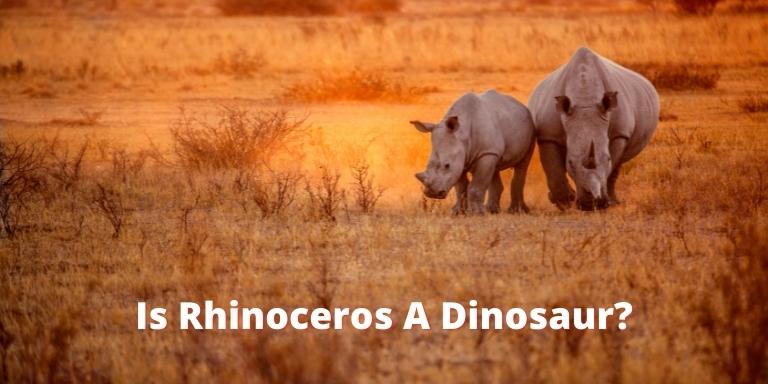
How Did Rhinoceros Get Its Name?
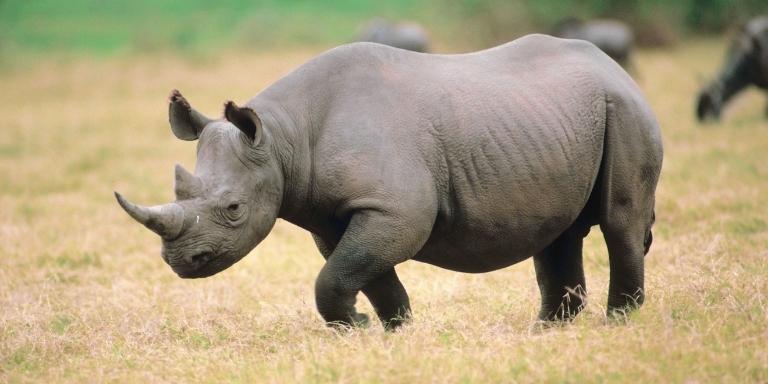
The naming of the animal is quite simple. “Rhinoceros” comes from the Greek words “rhino” which means “nose” and “ceros” means “horn”. So rhinoceros means nose-horn. The name is perfect considering its physical appearance & needs no explanation.
Scientific Classification
Kingdom: Animalia
Phylum: Chordata
Class: Mammalia
Order: Perissodactyla
Family: Rhinocerotidae
The scientific name (Genus and Species) for different types of rhinos are as follows,
White Rhinoceros: Ceratotherium simum
Black Rhinoceros: Diceros bicornis
Javan Rhinoceros: Rhinoceros sondaicus
Indian Rhinoceros: Rhinoceros unicorns
Sumatran Rhinoceros: Dicerorhinus sumatrensis
Rhinoceros Family Tree
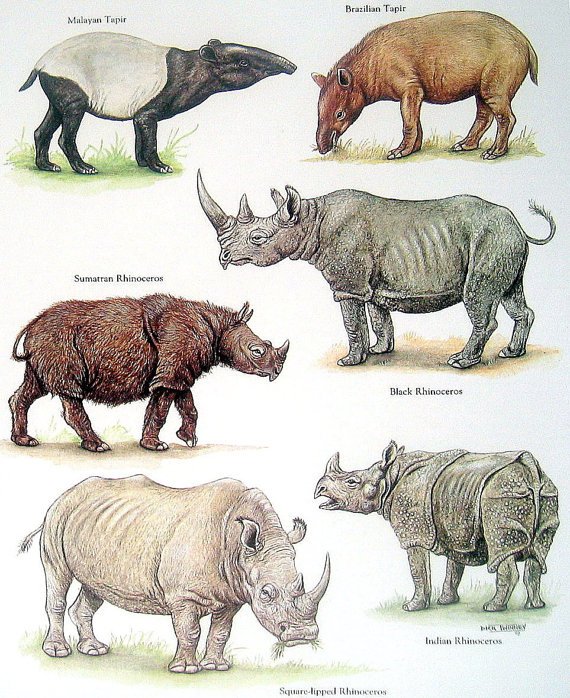
The Rhinoceros family is very broad, and many animals are related. Such as tapirs. Horses and Zebras are also linked in other ways. They all belong to the Perissodactyla family. It means “odd-toed” ungulates. The even-toed ones belong to a different family named “Artiodactyla”.
However, there are two major types of rhinos, depending on where they live. One is African, and the other is Asian. Both lineages got separated about 16 million years ago. There are currently five species of rhinos living on the planet.
But scientists claim that there used to be 8. Three of the types went extinct over time.
Sadly, the extinct rhinos had low diversity biologically. It means that their extinction was bound to happen eventually. Scientists have also found out that they had lower levels of inbreeding. These caused their species to get erased from the face of the earth slowly.
But the other five rhinos that survived were different. Despite having low diversity, they had higher levels of inbreeding. But their population seems to be decreasing very fast. This is undoubtedly the effect of climate change, poaching, loss of habitat, etc.
Some recent discoveries prove that rhinos and horses are related. They have a common ancestor, the fossil of which was found back in India in 2014.
The fossil of cambaytherium thewissi was found through a series of excavations. Over 200 bones of the creature were found throughout different places in India. Scientists have found that they were primitive and quite similar to modern-day tapirs. It is the common ancestor of rhinos, horses, and tapirs.
Rhinoceros Evolutionary History
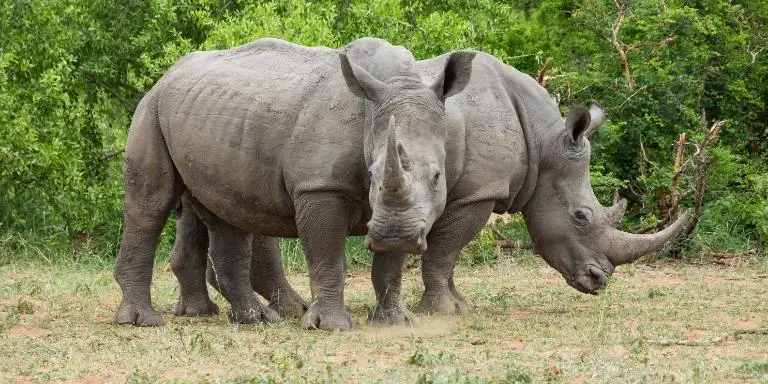
Rhino belongs to a huge family. They had a diverse clade named Rhinocerotoidea. But in modern times, only five species of rhinos have survived. The family is named Perissodactyla.
At the beginning of the Eocene age
The fossils of the Perissodactyla family prove that they were highly successful and diverse from the beginning of the Eocene period (55.5 million years ago). That is the time when they first appeared in the world.
From then till the last ice age (about 10,000 years ago), their families diverged across the globe successfully. But after the extinction of dinosaurs (about 65 million years ago), mammals began to acquire large bodies to fill up the ecological gap created in the world. Eventually, the first Perissodactyls appeared during the beginning of the Eocene age (55.5 million years ago).
Rhinocerotidae diverged from tapirs 55 to 60 million years ago in either Eurasia or North America. One of the members of this family is Paraceratherium, a gigantic beast that used to live in Asia about 15 to 35 million years ago.
This family diverged into hundreds of species that lived throughout the world. They were quite a sight to look at as some of them were one of the biggest living creatures in the world in that period.
But most of them went extinct during the Pleistocene age, and only 8 or 9 of them were alive during the late Pleistocene. There were the Siberian unicorn, Merck’s rhino and its relative, and the wooly one.
The early Eocene period
During the early Eocene age, the odd-toed ungulates had split into two species. One of them is Ceratomorpha. These consisted of many kinds of rhinoceros from today.
The Miocene period
During the Miocene age (23 million years ago ), the rhinoceroses developed unique characteristics to survive the contemporary world. They migrated to Africa during this time.
The special characteristics gave rise to the growing number of rhinoceroses and Zebras in the continent of Africa. They continued their migration and reached South America in no time. Some of them even ended up in North America. Then they decided to stop there.
Recent status
Scientists are yet to discover the rhino properly. They are stuck with many fundamental questions. The process of finding the evolution is time-consuming, costly, and complex.
The history of the evolution of the rhinoceros is still hypothetical. Currently, there are three theories. All of them concern the evolutionary history of the animal.
But scientists are yet to confirm which one is more accurate. Lots of major evolutions have taken place over millions of years. After so many ups and downs, only 29000 rhinos remain in the world.
- The 1st theory about groups the giant based on horns. It states the Sumatran rhino to be a sister to the two African rhinos.
- The 2nd hypothesis says that Sumatran ones are sisters of the Indian and Javan species. Many theories also support this.
- A more recent analysis has disclosed that the Sumatran one is sister to the clade, including four other extant types.
The Hyracotherium
ancient Perissodactyls are known as Hyracotherium. They are very close to the living ungulates of today’s world. In fossils of Hyracotherium, many features were similar to the modern-day rhinos, such as the Nose horn.
Are Rhinos Dinosaurs

Rhinoceroses look like ancient creatures ruling the earth today. The prehistoric dinosaurs, with their high legs, leathery skin, and gigantic bodies, resemble the present-day rhino in many ways. So it is not uncommon to think of them as descendants of dinosaurs.
But is a rhinoceros a dinosaur? No, they’re not. Their species came into existence many millions of years later after the extinction of the dinos.
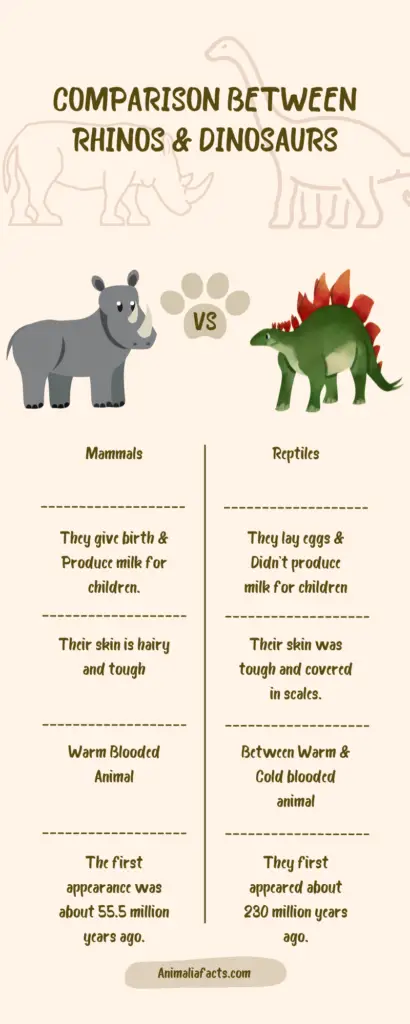
The Rhino of today’s world is a placental mammal. They give birth to their children and don’t produce eggs. Instead, the mother produces milk for the newborn. Though they don’t have much hair on their bodies, they still have more things in common with mammals.
For example, rhinos have lungs for breathing and are warm-blooded. They carry the child in their wombs for a long time and finally give birth to it. They are considered in the same room as ungulates with an odd number of toes and share their position with many other mammals of today’s world.
On the contrary, the dinos were reptiles. They had big and tough scales on their skin and had zero hair. They didn’t produce milk. Instead, they laid eggs for reproduction.
Moreover, they are considered between warm and cold-blooded reptiles. In short, despite rhinoceroses having a prehistoric appearance, they are far from being related to dinos.
Dinosaur That Looks Like a Rhino
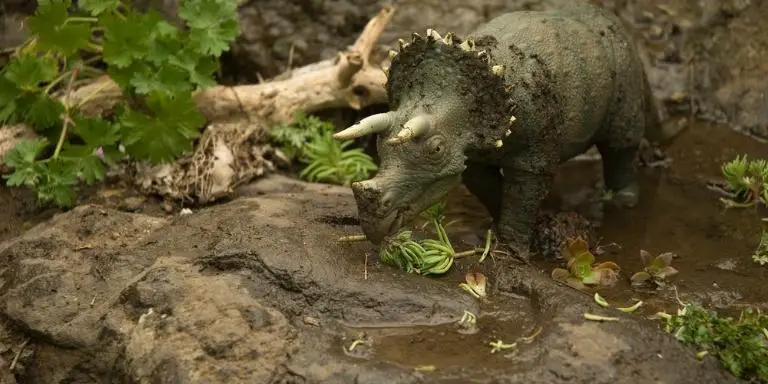
Rhinos resemble the dinosaur named Triceratops. The massive body structure, the big fat feet, the broad pointy horns, and the rough skin all look very much similar to both of them. Another less familiar dino called Centrosaurus also has similar features to that of a rhino.
Some Distinguishing Features
The triceratops is a non-avian dinosaur. It had three horns and used to be 30 feet long. Their weight was about 12000 to 16000 pounds. The quadrupedal animal had to carry a fat chunk of bone on the back of its skull.
Fossils even prove that their horns used to be up to 45 inches long. Their bones were dense, and the giant skull weighed about one-third of the body.
Triceratops used to be one of the heaviest creatures that lived on the face of the earth. Their frill was used to protect the neck from predators. Many frills of the fossils were found with bite marks. Such frills are found in many reptilian beings today.
The most curious thing about them is that they had beak-shaped mouths even though none of them were ever related to a bird. Their horns and frill used to shape differently as they age. This allowed scientists today to calculate the age limit of the creature from the discovered fossils. Their nature was friendly and calm.
While the modern-day rhino is pretty aggressive. Its prominent feature is its horn on the nose. It has single or double horns based on the species and is 12 to 13 feet long. They weigh about 4500 pounds generally.
Some Common Features
Interestingly, Triceratops and Rhino are herbivores. The triceratops used to live on grass, twigs, branches, leaves, fruits, and so on. It is the same as today’s rhino.
Both are tough-skinned, which allowed them to protect themselves from insect bites, temperature spikes, or attacks from carnivores or their other contemporaries.
The horns have many things in common also. Because for both of them, this organ is used for self-defense, daily activities, etc. The solid horns provide a robust shape to the head. But rhinoceros horns are made of keratin, the fundamental element found in nails and hair.
In contrast, the Triceratops’ horns were attached to the skull of the being. It was a solid structure from top to bottom and was made of bone.
Factually, no matter how many similarities we may assume about them, scientists have declined any possibility of them being related in any way.
Moreover, scientists are planning to stick to this decision based on their findings till today. But who knows, maybe discoveries soon can change all that. Till then it is confirmed that rhinos are not related to dinos. Even there seem to be no remote connections.
Related Article: Triceratops vs Rhino | Who Would Win in a Fight?
Extinction of the Rhino Species
Extinction of the Woolly Rhino
Woolly rhinos used to live in Siberia. But about 14000 years ago, their decline started. A study on ancient DNA suggests that the climate started getting wet and hot during that time, which triggered the decline. They died out completely about 5 to 6 thousand years ago.
Extinction of the Siberian Unicorn
The Siberian Unicorn lived in Kazakhstan at the same time as modern humans. They used to graze the open grasslands, but they started to die out about 39000 years ago due to natural scarcity.
Extinction of Merck’s Rhinoceros
Stephanorhinus kirchbergensis is the scientific name for the Merck’s rhinoceros, or the forest rhinoceros. They were native to Northern Eurasia and went extinct from the middle to the Late Pleistocene epoch.
The Recent Decline of the Northern White Rhinos
Only two female northern white rhinos remain in the world now. So it is a sad conclusion that the creature will be extinct in no time. Excessive poaching, habitat loss, climate change, etc., are the reasons for their being in this position.
Conclusion
Rhinos are closer relative to horses, tapirs, etc., with a single hoof and are placental mammals. Their family is different from that of the dinosaurs. However, all of their ancestors were herbivores. Some were even taller than giraffes.
You might also be interested in:
